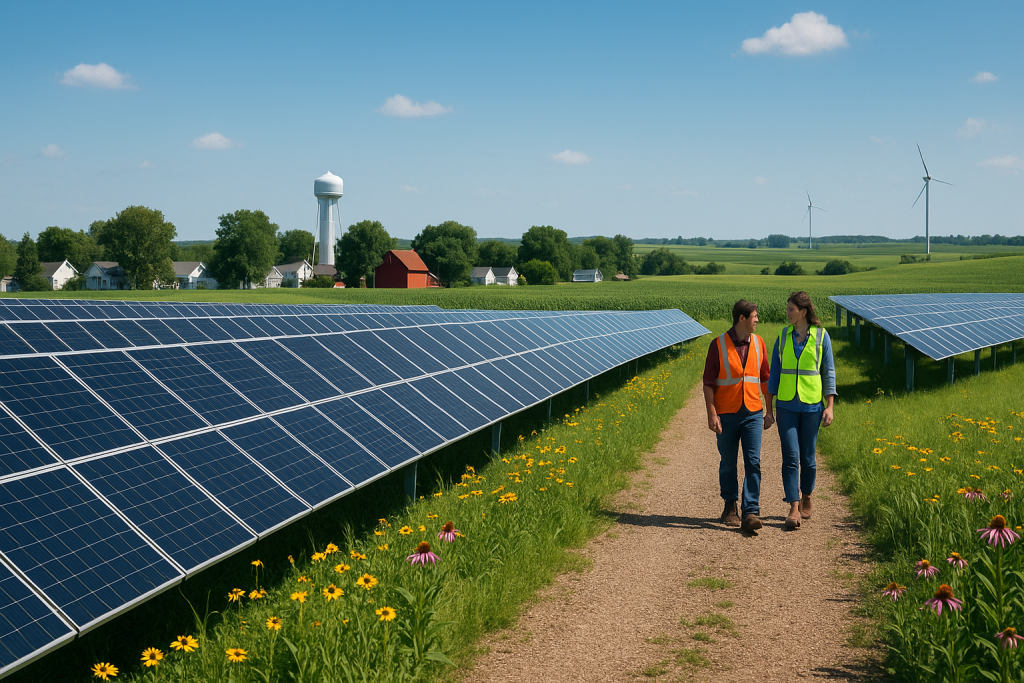
Some days it feels like wind gets all the glory in Iowa. Big turbines, big numbers, big headlines. Meanwhile, something quieter has been reshaping the grid from the neighborhood level: community solar. Over just the past five years, three local programs—the Cedar Rapids garden with Alliant Energy, Osage Municipal Utilities’ new voluntary offering, and the City of Ames’ SunSmart farm—have shown that small, carefully designed projects can deliver steady power, real household savings, and trackable environmental gains. Nothing flashy. Just working.
Cedar Rapids first, because it filled up fast. Alliant’s 4.5-MW community solar garden went live in February 2024 and is fully subscribed—300-plus customers bought in by the “block,” each block representing 250 watts. For twenty years, participants receive monthly bill credits with a floor of 5.59¢/kWh; payback is estimated at about a decade, which is why seats vanished. If you run a conservative 20% capacity factor, the site should generate around 7.9 GWh annually—roughly enough for 770 average Iowa homes (EIA pegs the average at about 846 kWh/month). Using EPA’s eGRID for our region (MRO West), that output avoids in the ballpark of 3,350 metric tons of CO₂ each year. Also underrated: daytime solar close to where people actually use power. It trims peak loads, reduces line losses, and takes a little stress off feeders on those sticky July afternoons.
Quick math on the wallet side (illustrative, but helpful): Alliant priced blocks at $291, with a one-time $35 enrollment fee. Their example shows 15 blocks—about 3.75 kW—producing roughly $453 in credits the first year and about $8,700 over 20 years. No wonder it sold out.
Osage tells a different story—municipal utility, same common-sense vibe. OMU launched a voluntary community array expected around 792 kW at 412 Joseph Lessard Court. Residents buy capacity in 143-watt “units” for $50 apiece and receive production credits for 20 years at $0.076/kWh. Keep the same conservative performance assumption (about a 20% capacity factor) and a single unit produces roughly 251 kWh per year, or about $19 in credits. That pencils to a payback of roughly two and a half years and excellent lifetime value after that. At full buildout, annual production lands near 1.39 GWh—around 135 homes’ worth—and avoids roughly 590 metric tons of CO₂ per year. For a muni, that’s local wealth cycling back to local customers—plus sturdier feeders at midday when you need them.
Then there’s Ames, which has been at this a bit longer. SunSmart Ames (2 MW) came online in 2020 and continues to add subscribers via “Power Packs” of 175 watts each. The one-time buy-in steps down annually (currently about $225–$240 per pack), while monthly bill credits flow for 20 years. With a 20% capacity factor, SunSmart produces roughly 3.5 GWh annually—enough for about 345 homes—and avoids around 1,490 metric tons of CO₂ a year. Financially, a single Power Pack tends to return about a dollar per month in credits. As the entry price drops, payback quickens for late joiners—keeping the door open for renters and homeowners who can’t host rooftop panels.
Why do these projects keep working? A few grounded reasons:
Participation is simple, the credits are predictable. You pay up front, then see the credit line on your bill for two decades. Leaders like fixed terms and math you can show on one page.
Solar shows up when the distribution grid appreciates it most. Midday generation lowers feeder stress and line losses, and it pairs neatly with Iowa’s wind profile, which is often strongest at night. Together, they reduce price spikes and reliance on peakers.
Dollars stay closer to home. Subscriptions, lease payments, O&M jobs—more of that value circulates in town, which matters for smaller budgets.
The emissions math is measurable, not hand-wavy. Even modest arrays avoid hundreds to thousands of tons of CO₂ each year, and cities can log progress with EPA eGRID factors for climate or air-quality plans.
If you’re a local decision-maker, there’s a pattern worth borrowing. Start with a size that fits your feeders and community demand. Spell out transparent pricing and credit formulas. Lean on proven formats—Ames’ Power Packs, Alliant’s blocks, OMU’s units—so residents grasp the offer in minutes, not hours. The past five years suggest you don’t have to wait for a utility-scale build or a “perfect” policy window to add meaningful clean capacity. Community solar isn’t a ribbon-cutting photo op; it’s practical infrastructure that pays local dividends—month after month—for twenty years.
